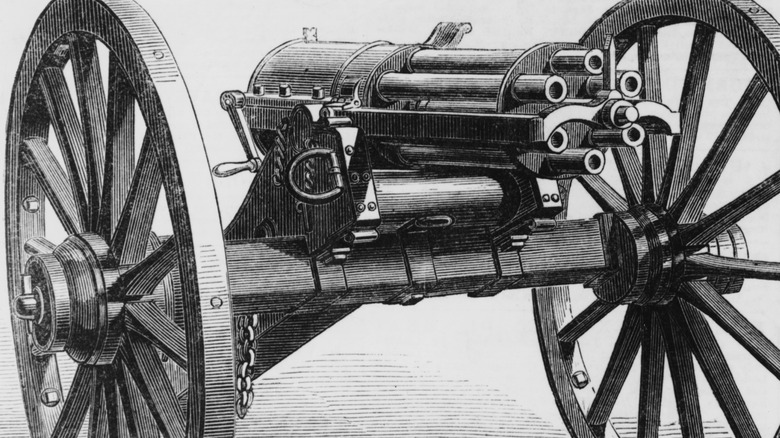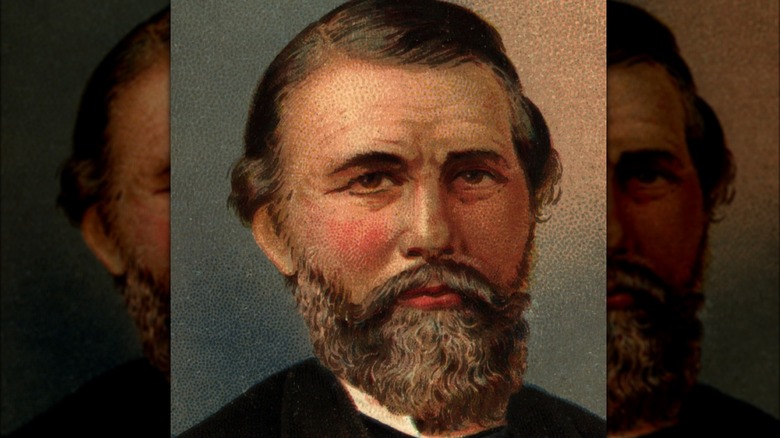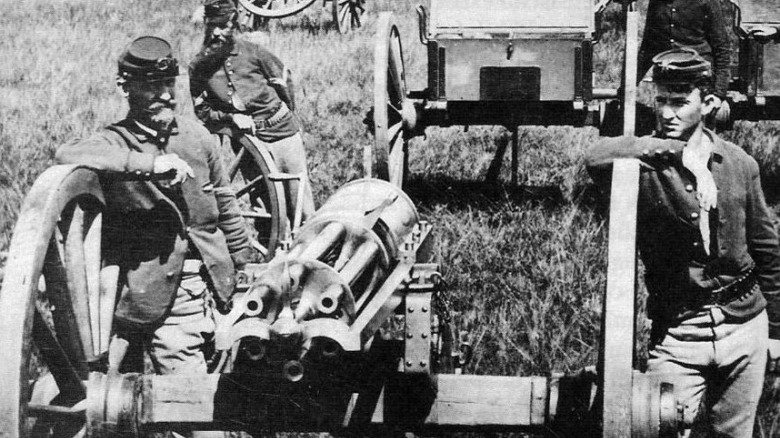The Real Reason The Gatling Gun Was Invented Might Surprise You
War was a much different prospect in the mid-1800s, compared to modern times. While today it's commonplace for handguns to hold about 17 rounds, in the days prior to the Civil War, weaponry was far less advanced. In fact, just before the war started in 1861, most weapons available to soldiers in the field were either single shot handguns or rifles (via Middlecreek) that had to be manually loaded with gun powder and a bullet before the weapon could be fired. Particularly destructive was a type of bullet known as a Minie ball, a hollow based type bullet that delivered especially vicious damage (via Historynet).
That would change, however, in November of 1862. Inventor Richard Jordan Gatling received a patent for a new type of weapon that would drastically change warfare going forward (via History). Born in Maney's Neck, North Carolina on September 12, 1818 (via Britannica), Gatling began early on helping his father improve tools and machinery they used to harvest cotton.
A weapon for peace
According to History, Richard Gatling received his first patent for a new kind of seed planter in 1844. Over the subsequent years, Gatling continued to improve upon his seed planter, as well as invent a whole host of other types of farming equipment. In 1850, after suffering from a bout of smallpox (via Britannica), Gatling developed a passing interest in medicine. With the approach of the 1860s and the early battles of the Civil War breaking out, Gatling became inspired after witnessing the horrors of battle (via Chicago Tribune). Noticing that far more soldiers died from disease than from bullets, Gatling reached back into his past for an idea that he hoped, in the end, would spare the need for massive armies.
Adapting his original idea of the automatic seed planter, Gatling created a device that had 6 to 10 rifle barrels arranged in a circular pattern. Connected to a hand crank, the barrels would begin to rotate once the crank was turned. On top of Gatling's new weapon was a hopper, a funnel type device (via Merriam-Webster) that fed bullets into each of the rifle barrels as they rotated by. Through the use of gravity, the bullets locked into place, were "automatically" fired and the empty cartridge being ejected all within the time of the weapon being cranked (via Encyclopedia).
Death, automatically
According to Encyclopedia, Gatling's gun could fire up to 350 rounds in a minute. In some of the early trials, the weapon reportedly fired 1,000 rounds in one minute. Compare that to the rate of fire of most single-shot infantry rifles, of two or perhaps three rounds per minute at best. After dealing with issues like frequent jams, and needing a crew of four soldiers to navigate the enormous weapon on the battlefield, Richard Gatling was awarded the patent for the weapon later to be dubbed "the Gatling Gun" in November of 1862 (via History).
And while the weapon would see limited use in the Civil War, due to it being relatively untested in battle, the Gatling Gun's presence in wars thereafter continued to be more and more prominent. Richard Gatling's original intent for the weapon, to drastically reduce the need for armies, unfortunately was never fully realized. According to History, Gatling wrote a letter to a friend in 1877 documenting his hopes for the weapon. "It occurred to me that if I could invent a machine — a gun — which could by rapidity of fire, enable one man to do as much battle duty as a hundred, that it would, to a great extent, supersede the necessity of large armies, and consequently, exposure to battle and disease be greatly diminished (via "Mr. Gatling's Terrible Marvel" by Julia Keller)." Unfortunately for Gatling, and the rest of the world, his technology would only be advanced upon in even more and more lethal ways. It did not eliminate the need for armies; the technology only enabled armies to kill more, and more quickly.


